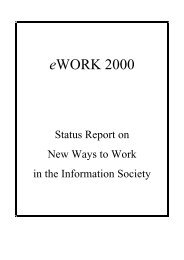Proceedings of 8th European Assembly on telework (Telework2001)
Proceedings of 8th European Assembly on telework (Telework2001)
Proceedings of 8th European Assembly on telework (Telework2001)
Create successful ePaper yourself
Turn your PDF publications into a flip-book with our unique Google optimized e-Paper software.
56Tele-cooperati<strong>on</strong> is already widely spread in Europe (see Table 6) with an average <str<strong>on</strong>g>of</str<strong>on</strong>g> almost 30%<str<strong>on</strong>g>of</str<strong>on</strong>g> EU workers practising it. In Finland around 50% and in the Netherlands and the UK and morethan 40% <str<strong>on</strong>g>of</str<strong>on</strong>g> workers tele-cooperate at least occasi<strong>on</strong>ally 4 . Again we can observe a north-southdivide in Europe with Spain (24%), France (27%) and Italy (27%) at the tail end. The data derivesfrom the General Populati<strong>on</strong> Survey (GPS) carried out as part <str<strong>on</strong>g>of</str<strong>on</strong>g> the ECaTT project in 1999 in 10EU countries.Table 6:Tele-cooperati<strong>on</strong> in Europe 1999Workers who tele-cooperate as % <str<strong>on</strong>g>of</str<strong>on</strong>g> all workersregularly (in %) occasi<strong>on</strong>ally (in %) never (in %)Denmark 26.0 5.9 68.1Finland 43.4 6.9 49.7France 21.7 4.8 73.5Germany 26.8 5.3 67.9Ireland 32.1 5.4 62.5Italy 17.6 9.8 72.6Netherlands 29.9 15.5 54.6Spain 19.7 4.2 76.1Sweden 29.9 7.9 62.2United Kingdom 37.5 5.2 57.3Data: ECaTT 1999 (Base: pers<strong>on</strong>s in paid work ) Source: empirica ECaTT 1999Decreases in transacti<strong>on</strong> costs such as those caused by ICTs are expected to result in theincreasing importance <str<strong>on</strong>g>of</str<strong>on</strong>g> self-employment vis-à-vis dependent employment. Outsourcing <str<strong>on</strong>g>of</str<strong>on</strong>g>activities formerly d<strong>on</strong>e by own staff to independent c<strong>on</strong>tractors and freelancers is <strong>on</strong>e <str<strong>on</strong>g>of</str<strong>on</strong>g> themechanisms through which this change process may be enacted. Many believe that growingnumbers <str<strong>on</strong>g>of</str<strong>on</strong>g> self-employed workers indicate a more flexible labour force as self-employed workersare faster in adapting to changes in the demand <strong>on</strong> the labour market in comparis<strong>on</strong> to employeesin permanent work c<strong>on</strong>tracts. The self-employment rate al<strong>on</strong>e, however, is not a suitable variableto measure the flexibility <str<strong>on</strong>g>of</str<strong>on</strong>g> a labour force because in country comparis<strong>on</strong>s the self-employmentrate tends to correlate positively, in particular, with the share <str<strong>on</strong>g>of</str<strong>on</strong>g> the workforce in the primary sector.For this reas<strong>on</strong>, countries <str<strong>on</strong>g>of</str<strong>on</strong>g> the developing world show much higher rates <str<strong>on</strong>g>of</str<strong>on</strong>g> self-employment thanadvanced capitalist countries, and today’s EU Member States experienced falling numbers <str<strong>on</strong>g>of</str<strong>on</strong>g> theself-employed for the greater part <str<strong>on</strong>g>of</str<strong>on</strong>g> 20th century.In recent years, however, there has been a reversal <str<strong>on</strong>g>of</str<strong>on</strong>g> the overall trend <str<strong>on</strong>g>of</str<strong>on</strong>g> falling self-employmentrates in most EU countries (if the primary sector is excluded 5 ). This development is attributed toa number <str<strong>on</strong>g>of</str<strong>on</strong>g> new possibilities for self-employed businesses which have opened up throughout theec<strong>on</strong>omy, many <str<strong>on</strong>g>of</str<strong>on</strong>g> which are related to the use <str<strong>on</strong>g>of</str<strong>on</strong>g> ICTs:4 The defi niti<strong>on</strong>s used are as follows: Occasi<strong>on</strong>al tele-cooperati<strong>on</strong>: Workers who collaborate with others not located <strong>on</strong> thesame site (either externals or same-company workers located in other establishments) at all, using email, video-c<strong>on</strong>ferencing,the transfer <str<strong>on</strong>g>of</str<strong>on</strong>g> computer fi les or share joint databases (e.g. Intranet); Regular tele-cooperati<strong>on</strong>: Workers who use e-mail forcollaborati<strong>on</strong> with others not located <strong>on</strong> the same site daily, or use video-c<strong>on</strong>ferencing or fi le sharing at least <strong>on</strong>ce a week.5 Agriculture has a large infl uence <strong>on</strong> nati<strong>on</strong>al self-employment rates because it c<strong>on</strong>tains a high share <str<strong>on</strong>g>of</str<strong>on</strong>g> all self-employed in everycountry, and is shrinking fast.








